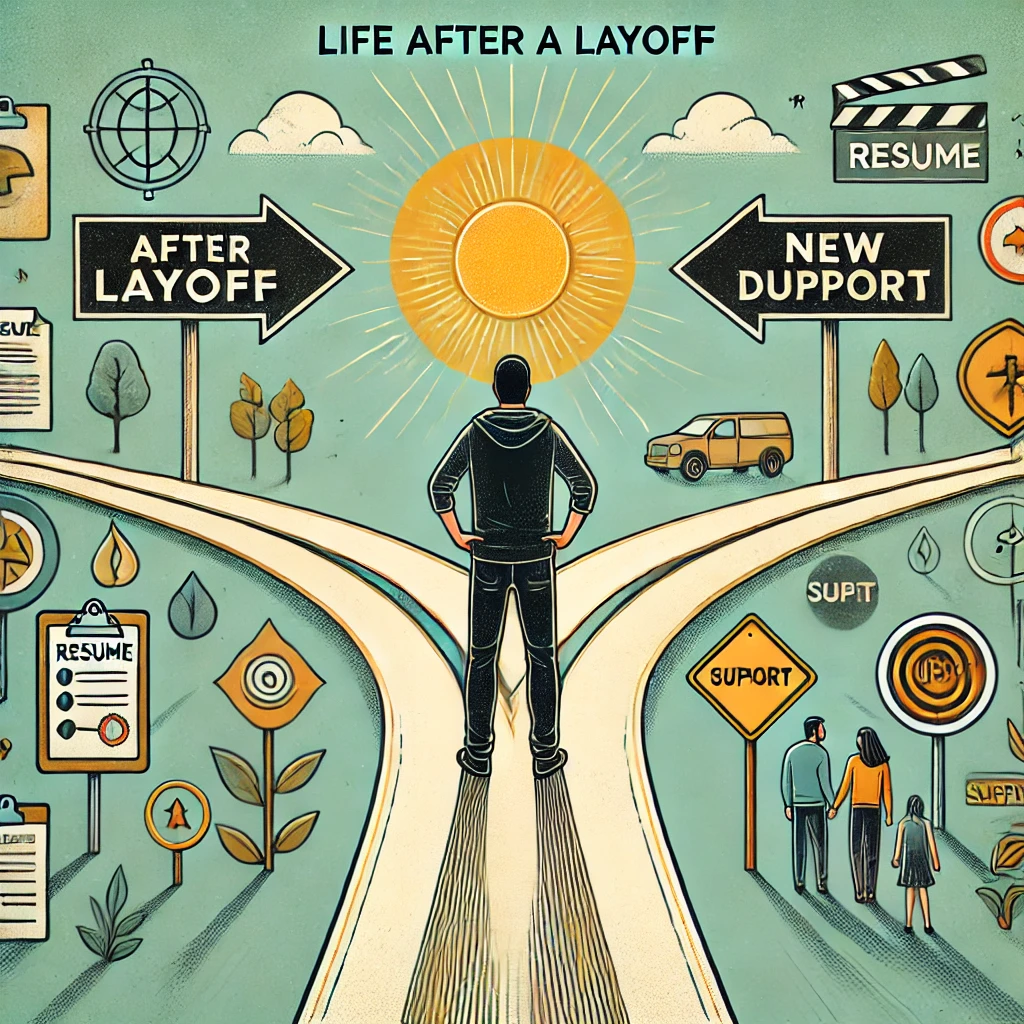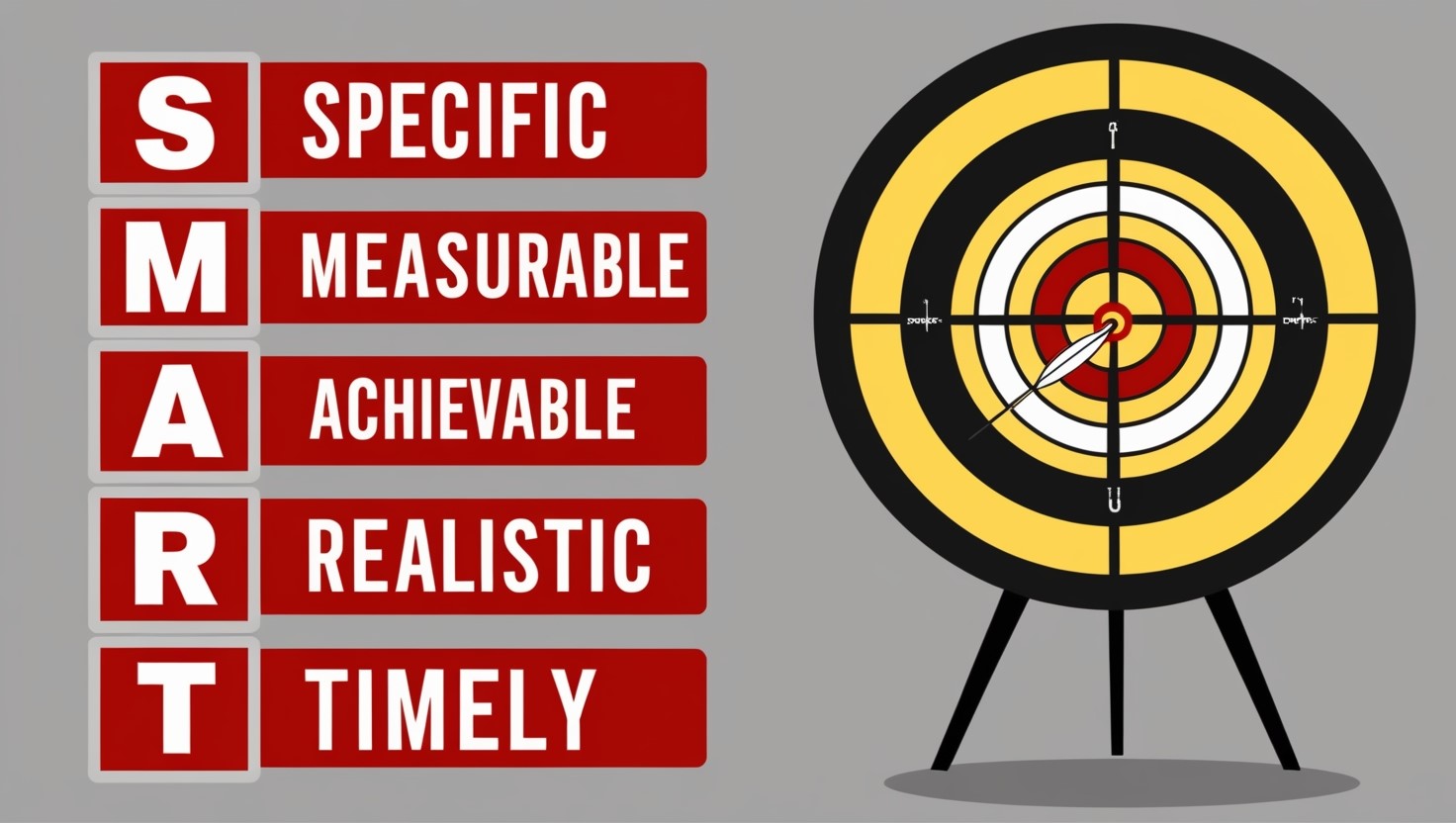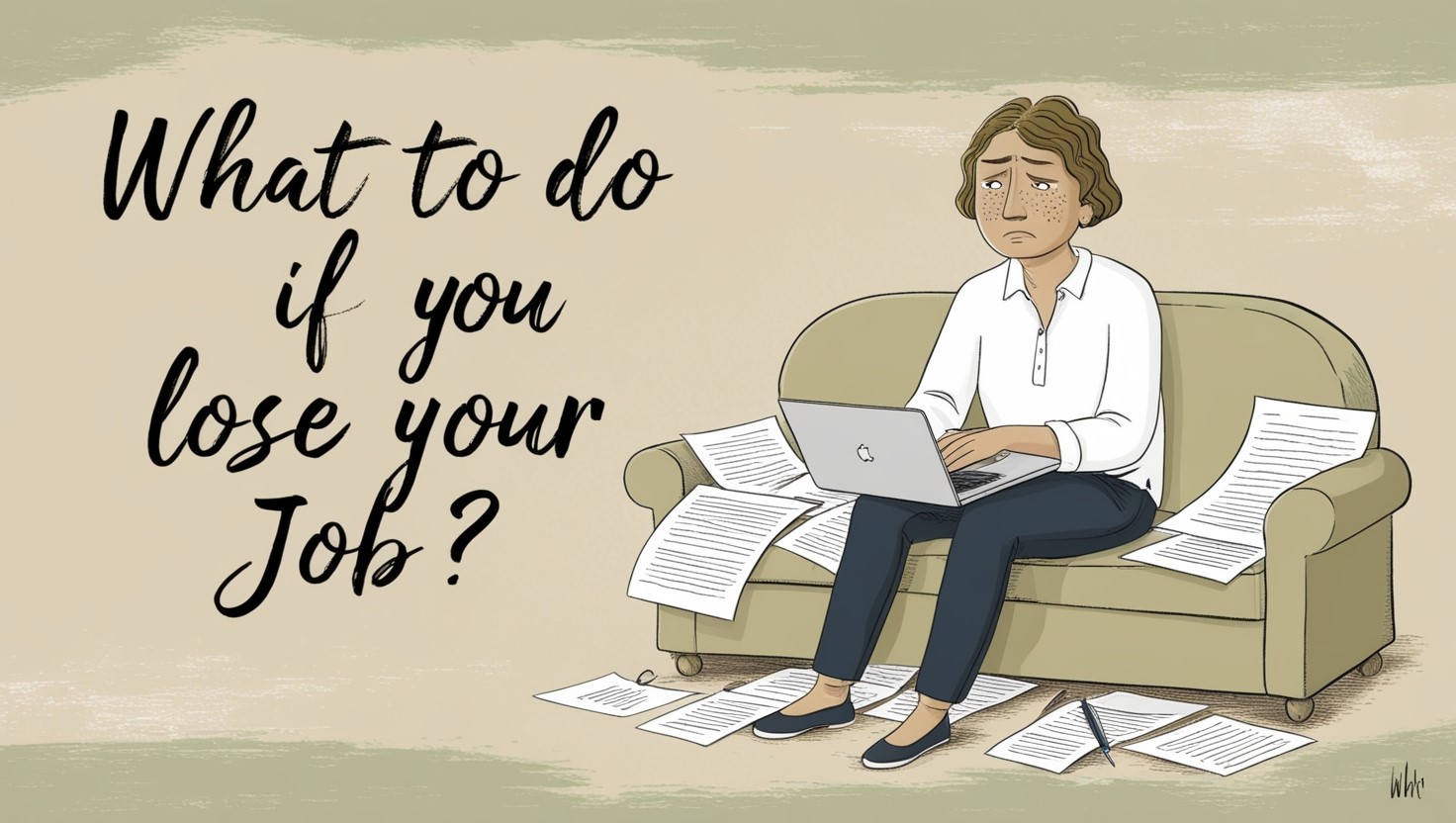Losing a job can be a shock, both emotionally and financially. It’s a moment that often brings uncertainty, fear, and frustration. Whether the layoff was expected or came out of the blue, it’s normal to feel overwhelmed by the sudden change. But while being laid off is undoubtedly tough, it can also be the start of a new chapter. By focusing on a few key steps, you can start to regain your footing and move toward a fresh opportunity.
Recovering from a layoff takes time, patience, and effort, but the right approach can help you rebuild your confidence and create a path forward. In this guide, we’ll walk through practical actions you can take to stabilize your financial situation, rebuild your career, and prioritize your well-being. These steps are designed to help you navigate the transition and come out stronger on the other side.
Step 1: Allow Yourself to Process the Situation
When you first get laid off, it’s easy to jump into action mode—updating your resume, scouring job boards, and reaching out to contacts. But before diving headfirst into the job search, it’s important to take a step back and process what just happened. Losing a job can feel like a personal setback, and it’s okay to feel disappointed, anxious, or even angry. Giving yourself permission to feel those emotions is part of the healing process.
Take some time to reflect. What led to the layoff? Was it something beyond your control, like a company downsizing, or was there something you can learn from the experience? Processing these thoughts can help clear your mind and prepare you for the next steps with a fresh perspective.
Use this time to take care of yourself mentally and emotionally. Lean on your support system—talk to friends, family, or even former colleagues about what you’re going through. Sometimes, simply sharing your feelings can help ease the burden. Practice self-care, whether it’s through exercise, meditation, or just taking a few days to rest and recharge. It’s not about rushing to the next thing; it’s about giving yourself the mental space to regroup.
Remember, being laid off doesn’t define you, and this moment doesn’t have to be a setback forever. By allowing yourself to process the situation, you’ll be in a better place mentally to tackle what comes next.
Step 2: Assess Your Financial Situation
Once the dust has settled, it’s time to take a clear look at your finances. Being laid off can feel like a financial punch, but taking control of your money early on can help ease some of the stress. Start by understanding where you stand—review your current savings, any severance package you might have received, and your monthly expenses. Knowing exactly what you have to work with is the first step in planning for the months ahead.
Create a budget that reflects your new situation. Focus on covering the essentials first—things like rent or mortgage, groceries, utilities, and health insurance. If you need to cut back on non-essential expenses, this is the time to do it. It’s not about giving up everything, but about being smart with the resources you have until your income is back on track.
If you have debt or recurring payments, reach out to creditors or service providers. Many companies are willing to offer temporary relief or lower payments, especially if you’re upfront about your situation. It’s better to have those conversations early rather than wait until things become overwhelming.
Also, consider whether you’re eligible for unemployment benefits. It may not cover everything, but it can provide some much-needed financial breathing room while you focus on finding your next opportunity. Every bit of income helps during this transition.
By getting a handle on your financial situation early, you’ll be able to make informed decisions about the future. It’s not easy, but having a plan in place will help you feel more secure as you take the next steps in your recovery.
Step 3: Update Your Resume and Online Profiles
With your financial situation under control, it’s time to focus on your next move—getting back into the job market. The first step in that direction is refreshing your resume and online profiles. Think of your resume as your personal marketing tool. It should highlight your most recent experience and accomplishments, showing potential employers why you’re the right fit.
Start by updating your resume with the latest information about your most recent role. Don’t just list your responsibilities—focus on the results you achieved. Whether it was leading a successful project, improving processes, or hitting key targets, showcasing specific outcomes can make your resume stand out. Tailor your resume to the types of positions you’re targeting, making sure to include relevant skills and experience that align with those roles.
Next, update your LinkedIn profile and other professional platforms you use. Employers often check these profiles before contacting you, so make sure they reflect your current skills and experience. LinkedIn, in particular, is a powerful tool for networking and job searching. Update your headline to reflect your expertise or desired role, and add any new achievements, certifications, or skills.
If you’ve been out of work for a little while, don’t shy away from acknowledging it. You can use this time to highlight any professional development you’ve undertaken—whether it’s online courses, freelance projects, or volunteer work. Employers appreciate candidates who keep their skills sharp, even during gaps in employment.
Lastly, ensure your contact information is up to date on all your profiles. Make it easy for recruiters and hiring managers to reach out to you. By having a polished, current resume and online presence, you’re setting yourself up for a better chance at landing your next role. It’s a simple step, but an important one in getting back on your feet after a layoff.
Step 4: Tap into Your Network
One of the most powerful tools in your job search isn’t found on job boards—it’s your network. After being laid off, now is the time to reach out to colleagues, friends, mentors, and other professional contacts. Don’t hesitate to let people know you’re looking for new opportunities. Most jobs are filled through connections, and your network can open doors you might not even know exist.
Start by contacting former coworkers or supervisors who can speak to your skills and work ethic. They may have leads on open positions or be willing to provide a recommendation. Let them know what type of role you’re seeking and ask if they can keep an ear out for opportunities.
Beyond your immediate circle, consider reaching out to industry contacts or people you’ve connected with at conferences or events. Even a brief message updating them on your situation can be enough to spark a conversation or lead to a potential referral. Networking isn’t just about asking for help; it’s about re-engaging relationships and staying visible in your professional community.
Don’t overlook online networking either. LinkedIn is a great platform to reconnect with contacts and expand your network. Engage with posts, share relevant industry content, or even send direct messages to people in your field. The more active you are, the more likely you are to come across new opportunities.
Finally, attend virtual or in-person networking events, webinars, or industry meetups. These can be great places to meet new people, learn about emerging trends, and possibly find job leads. Remember, your network is your support system during this time. By tapping into those connections, you increase your chances of finding your next opportunity while also building relationships that can last far beyond your job search.
Step 5: Explore Job Opportunities and Retrain if Necessary
Once you’ve reconnected with your network and updated your profiles, it’s time to start actively exploring job opportunities. Begin by researching roles that align with your experience and skill set. Job boards, company websites, and industry-specific platforms are good places to start. As you browse through listings, don’t limit yourself to only the roles you’ve done in the past—consider positions that challenge you in new ways or industries you haven’t explored yet.
If you notice that the jobs you’re interested in require skills you don’t have or if the industry you were working in is shrinking, now might be the perfect time to retrain or upskill. This doesn’t mean starting from scratch, but rather adding to the expertise you’ve already built. Look for online courses, certifications, or workshops that can help bridge any gaps in your qualifications. Many platforms, like Coursera or LinkedIn Learning, offer affordable (sometimes free) courses that you can complete at your own pace.
For some, retraining might mean shifting to a different field altogether. If your industry was hit particularly hard, consider roles in sectors that are growing. For instance, if you’ve always worked in retail but have an interest in digital marketing, now might be the time to take a certification course and transition into that space. Upskilling can not only make you more competitive in the job market but also open up new career paths you may not have considered before.
Keep an open mind as you explore new opportunities, and don’t hesitate to apply for roles where you may not check every box. Employers often value adaptability, a willingness to learn, and a diverse background. By staying proactive, whether through job applications or retraining, you’ll increase your chances of finding a role that suits both your current situation and your long-term career goals.
Step 6: Stay Organized and Proactive in Your Job Search
When you’re searching for a job after being laid off, it’s easy to feel overwhelmed by the sheer number of applications, interviews, and follow-ups. That’s why staying organized and proactive is key to keeping your momentum going. Treat your job search like a project—set daily or weekly goals, keep track of your applications, and consistently follow up with potential employers.
Start by creating a system to organize your job hunt. Whether it’s a simple spreadsheet or a task management app, tracking where you’ve applied, the status of each application, and any upcoming interviews helps you stay on top of things. Note important dates, such as follow-up deadlines after interviews, and make sure you’re not losing track of promising leads. Having everything in one place will keep you focused and reduce the stress of trying to remember where you are in the process.
Set a daily schedule dedicated to your job search. Block out time for researching opportunities, tailoring your resume for each role, and reaching out to your network. A consistent routine not only keeps you on task but also helps you stay productive, even when the process feels slow. Job hunting can take time, but keeping a steady pace helps you stay motivated.
Also, don’t wait passively for responses. Be proactive. Follow up on applications after a reasonable time, politely checking in with recruiters or hiring managers. This shows initiative and keeps you on their radar. If you’ve had an interview, send a thank-you note expressing your appreciation and reinforcing your interest in the role. These small steps can make a big difference in setting you apart from other candidates.
Most importantly, stay patient. Job searching can be a long process, and it’s easy to get discouraged, especially after rejections or slow responses. Keeping organized and remaining proactive will help you stay in control of your search, giving you the confidence to keep moving forward.
Step 7: Consider Freelancing or Temporary Work
While you’re searching for your next full-time role, freelancing or taking on temporary work can be a smart way to maintain income and stay active in your field. These options not only provide financial support but also help you keep your skills sharp, build new connections, and even explore new industries or job types that might not have been on your radar before.
Freelancing offers flexibility. You can take on projects that fit your schedule, allowing you to continue your job search while earning money. If you have expertise in areas like writing, graphic design, marketing, or consulting, there are plenty of platforms like Upwork or Fiverr where you can find freelance opportunities. Even short-term gigs can add up and may lead to more permanent opportunities as clients often prefer to hire someone they’ve worked with before.
Temporary or contract work is another option. These roles are often available in various fields, from administrative support to technical jobs, and they provide you with a steady paycheck without the long-term commitment of a full-time role. Staffing agencies and job boards frequently list temp jobs, which can range from a few weeks to several months. Many temporary positions also have the potential to turn into permanent roles, giving you a chance to prove your abilities on the job.
By freelancing or taking on temporary work, you’re not just keeping your income steady—you’re also staying engaged in your field. These opportunities allow you to learn new skills, expand your network, and keep your resume fresh. Plus, showing potential employers that you stayed productive during your job search demonstrates resilience and adaptability, qualities that are highly valued in today’s workforce.
Ultimately, freelancing or temporary work can be more than just a stopgap—it can be a bridge to new opportunities, new connections, and perhaps even a new career path. Stay open to these possibilities as part of your recovery process.
Step 8: Take Care of Your Physical and Mental Well-Being
Being laid off can be stressful, both emotionally and physically. While it’s natural to feel anxious about finding your next job, it’s equally important to take care of yourself along the way. Job hunting is a process that takes time, and burnout can set in quickly if you’re not mindful of your physical and mental health.
Start by making your well-being a priority. This doesn’t mean you need to overhaul your lifestyle, but small daily habits can make a big difference. Get outside for a walk, do some stretching, or engage in whatever form of exercise works best for you. Physical activity helps clear your mind, reduce stress, and keep your energy levels up, which will help you stay focused and motivated during your job search.
Just as important as physical health is maintaining your mental well-being. The uncertainty of being in between jobs can take a toll on your confidence and outlook. Make time for activities that help you relax and unwind, whether it’s reading, meditating, or spending time with loved ones. Surround yourself with positive influences—talk to friends or family who lift you up, or connect with people who are also navigating job transitions. Sometimes, simply talking things through can relieve some of the emotional weight.
If you find yourself feeling overwhelmed or stuck, don’t hesitate to seek professional support. Whether it’s talking to a counselor or reaching out to a career coach, getting advice from someone who understands your situation can be incredibly helpful. These professionals can offer strategies for managing stress and staying resilient during your transition.
Taking care of your well-being isn’t just about surviving this period; it’s about thriving through it. When you feel healthy and centered, you’ll approach your job search with more clarity and confidence. Remember, this is a temporary phase—by prioritizing your physical and mental health, you’ll be better prepared to take on new opportunities when they come your way.
Step 9: Reframe the Layoff as a New Opportunity
Being laid off is hard, but it doesn’t have to be the end of the story—it can be the beginning of something new. While it’s normal to feel uncertain or even discouraged after losing a job, reframing the situation as an opportunity for growth can help shift your mindset. Instead of focusing on the loss, think of this time as a chance to step back, reassess your goals, and explore paths you might not have considered before.
Start by asking yourself what you really want from your next role. Were you truly satisfied with your last job, or were there aspects of it that left you feeling unfulfilled? This is your moment to redefine what success looks like for you. Whether it’s finding a better work-life balance, transitioning to a new industry, or pursuing a long-held passion, this break gives you the space to evaluate what matters most.
Use this time to explore new interests or revisit old ones. You might find that the layoff opens doors to opportunities you wouldn’t have pursued otherwise. Maybe it’s starting a side hustle, learning new skills, or even going back to school. The layoff, as difficult as it may seem, can serve as a springboard for personal and professional reinvention.
It’s also a good time to build resilience. The challenges you’re facing now can help you grow stronger in the long run. Overcoming setbacks teaches valuable lessons about persistence, adaptability, and finding new ways to succeed. Embracing this perspective can help you move forward with a renewed sense of purpose.
Reframing the layoff as a fresh start won’t happen overnight, but with time, you may find that this unexpected turn of events leads to exciting new possibilities. By viewing the layoff not as a setback but as an opportunity, you’re setting yourself up to approach the future with a mindset focused on growth, potential, and new beginnings.
Final Thoughts
Recovering from a layoff is no easy journey, but it’s one that can lead to new beginnings if approached with the right mindset. The key is to take things one step at a time—allow yourself to process the emotions, assess your financial situation, and get organized in your job search. It’s important to remember that you don’t have to go through this alone. Lean on your network, explore all opportunities, and be open to learning or even trying something new.
Freelancing, temporary work, or retraining can serve as helpful stepping stones while you work toward securing your next full-time role. Along the way, don’t forget to take care of yourself physically and mentally. Maintaining your well-being during this transition will help you stay grounded and focused.
Lastly, try to see this as more than just a setback. It’s a moment to rethink your goals, explore what truly fulfills you, and pursue new opportunities. Reframing the layoff as a chance to grow can give you the motivation to move forward with renewed energy. The road ahead may be uncertain, but with patience, resilience, and a proactive approach, you can come out stronger on the other side.



